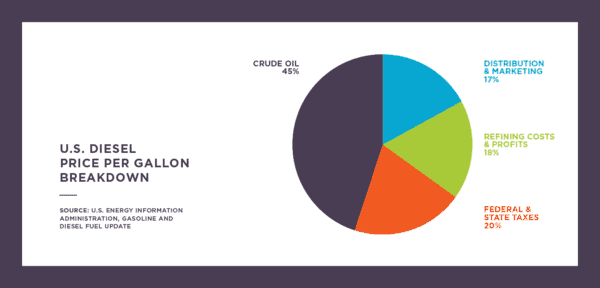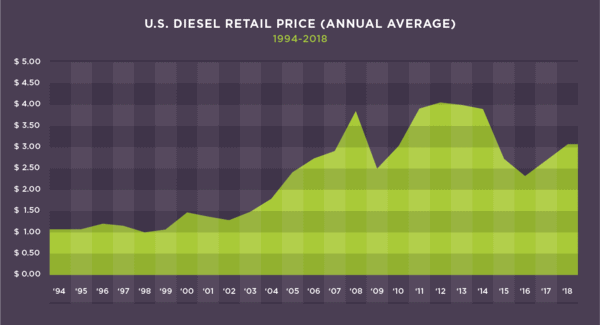
Diesel fuel is the lifeblood of the logistics industry, and the volatility of rate changes is something that causes issue among many shippers. Because of this, we watch diesel fuel prices closer than brokers watch tickers on the floor of the NY Stock Exchange.
There’s a method to the madness
Diesel fuel rates are tracked by the U.S. Department of Energy (DOE), who publishes the updated rates every Monday. These rates are compiled by the Energy Information Administration (EIA) using a statistical methodologies that include a nationwide survey that collects data on the cash price offered at pumps across the country. These diesel statistics are the industry standard used by freight and logistics companies to calculate the diesel fuel surcharges that affect freight rates.
Why are diesel rates higher than regular gasoline?
Prior to 2004, diesel fuel prices were lower than the average prices of regular gasoline. As diesel engines gained popularity among consumers, particularly in the U.S., China and Europe, the price of diesel fuel has climbed. Prices are high in the U.S. because of federal excise, state, and sales taxes as well as the costs of production and distribution, both of which were affected by the transition to ultra-low sulfur diesel (ULSD).
In 2015, diesel fuel prices dipped below the cost of regular gasoline for the first time since 2009. Today, diesel currently stands at an average of 30 cents more per gallon than regular gasoline, and the rates continue to climb year over year (rates are up 72 cents over this time last year).
What’s included in the price of a gallon of diesel fuel?
The total price we pay at the pump for a gallon of diesel fuel is affected by more than the price of crude oil. In total, crude oil makes up less than half of what goes into diesel fuel pricing. Other factors include distribution/marketing, refining costs, and taxes.

Pricing volatility continues to be an issue for shippers
Carriers and shippers have been watching diesel prices steadily rise over the years, adding to their growing list of concerns that include driver compensation and shortages, ELD mandates and other industry challenges.
The rise in diesel fuel prices dates as far back to 1994, where diesel fuel cost $1.10 per gallon. The volatility in pricing began when prices surged to almost $4.00 in 2008, only to drop down under $2.50 a year later. Prices would once again peak 2012 before dropping to about $2.25 in 2016. Since then, the monthly price of diesel has been trending upward, with significant increases being made month over month for the part couple of years.

And this upward trend shows no signs of braking anytime soon. The Organization of the Petroleum Exporting Countries (OPEC) has stated it will continue to cut oil production rates through the end of the year, which will continue to send rates on an upward trend for the foreseeable future.

Speaking of the future
The EIA’s short-term energy outlook is forecasting crude oil spot prices to average $71/b for the remainder of 2018 and $66/b in 2019. U.S. production of crude oil is also expected to increase both in 2018 and 2019. Current projections for 2018 put U.S. crude oil production at an average of 10.7 million barrels a day, well over the previous record of 9.6 million barrels a day, which was set in 1970. Could the news get even better? It does. The EIA is projecting crude oil production will average 11.4 million barrels a day in 2019, providing some much needed relief to the prices in the logistics industry. U.S. production of crude oil can also lead to greater cost control as the nation becomes less dependent on negotiations with the Organization of the Petroleum Exporting Countries (OPEC) and other entities.
For every issue, there’s a solution
You didn’t think we would just outline the problem and call it a day, did you? What would King be without the Solutions, after all? The good news is that fuel-saving alternatives modes of transportation do exist, and the King team can help your business take advantage of them.
Our seasoned load planning and optimization experts, combined with a vast and ever-growing carrier network, allow shippers to better manage fuel use while creating a greener, more efficient supply chain. We believe that one shipping option isn’t good enough. That’s why we help our clients choose between many. When over-the-road (OTR) transportation or (LTL) shipping isn’t the most efficient, we help facilitate shipments via rail lines.
But despite our years of expertise, we have never become set in our ways. Innovation is what drives this industry. Electric trucks, an initiative currently being spearheaded by Tesla, is one of the hottest topics in the industry currently. This initiative is currently being spearheaded by Tesla, and larger companies like Walmart, JB Hunt, UPS, Pepsi, DHL and FedEx have already placed orders. We will be watching this technology closely as innovations are made.
In the meantime, we will continue to leverage our SmartWay partnership with the EPA to help our partners find the most qualified carriers. King has been an approved 3PL provider since 2010 and continues to help our partners with their sustainability efforts. To discover more about how we can help your business become more sustainable, ask a King Solutions representative about our ThinKING Green program.
Ready to talk solutions? Want to learn more about how King is combating the rising costs of diesel fuel? Get in touch with King Solutions today.







 Joel Rice
Joel Rice